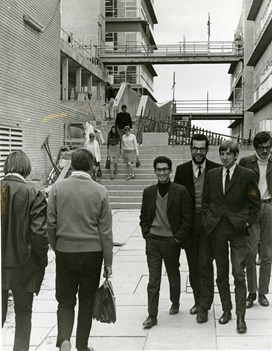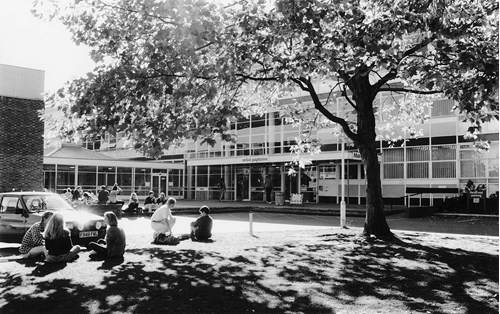Vic Slater, Founding Chair of AUDE 1992 - 93
Malcolm Swann, AUDE Chair 1994 - 96
After the Second World War the UK government of the time introduced an education strategy that envisaged massive increases in student numbers in higher education. This demanded expansion of the existing university estates as well as the creation of totally new universities. In the very early days, management of the university estate often fell to a bursar, or equivalent. The first national meetings to discuss estates matters were, in fact, special sessions at the annual conference of University Finance Officers in the 1950s. It was quickly recognised that specialist development managers were needed to oversee the expansion, and hence Buildings Officers came into existence as members of the senior management team of the university.
On behalf of the government, the expansion of the sector – and within this the allocation, control and monitoring of the capital programme – was implemented by the University Grants Committee (UGC) and later by the Universities Funding Council (UFC). The UGC modelled the development groups within the universities, creating a group of architects and quantity surveyors who liaised directly with the buildings officers to manage the capital programme. Characters of the era included Dennis Revell and Dennis Strachan at the UGC, and many of us will remember the discussions, debates and arguments about space norms and costs per square metre. The famous, or perhaps infamous, ‘red book’ was always the subject of many long debates.

University of Surrey, 1968
By the early 1980s government policy had gone into reverse with a strategy of reducing student numbers. Some universities at the extreme were faced with cuts of 40% in student numbers, only then for it to be pointed out that our estates were too large according to the red book.
With the appointment of buildings officers to manage the building expansion phase, an annual residential spring conference was established, to be held in a different university each year. In addition, there was an annual autumn meeting held in Senate House in London. As well as these national meetings, buildings officers found it useful to meet in regional groups to share local issues. Apart from these individual meetings, there was no ongoing body representing buildings officers. At a meeting of the North West Buildings Officers, an idea emerged to create an Association of Buildings Officers with a national Executive Committee and a Chairman. This was approved at the next annual conference and the Executive became a point of contact for the UGC, whose representative was invited to all meetings, and for the Committee of Vice-Chancellors and Principals.
By this time, universities had to adopt estate strategies based on rationalisation and long-term maintenance. Gone were the days of putting up lots of new buildings. University estates departments had to recognise this change and restructure their organisations to face the new challenges. Buildings officers were leading these changes and their job titles were also under consideration. Several different job titles came into being, centred on Facilities Management or Estate Management. This proliferation of job titles went on for a number of years; at the same time, universities were reorganising finance and HR departments and so on, and were adopting Director as a common title within the most senior administrative roles. It was inevitable and sensible for Estates to follow this model, and by the end of the 1980s the most common title for the heads of estate departments was Director of Estates.
It was clear by this time that a large number of the 1950s and 1960s expansion buildings were of poor quality and difficult to adapt for new academic initiatives: some had structural faults; almost all were energy inefficient; and most contained asbestos. This added to the challenges for the new directors of estates and again made them key to the future of universities.
While this was going on the UGC/UFC was also restructuring to recognise the changes to funding and the new challenges facing the sector. This resulted in the emergence of the Higher Education Funding Council for England (HEFCE), the Higher Education Funding Council for Wales (HEFCW) and the Scottish Higher Education Funding Council (SHEFC; now the Scottish Funding Council, SFC). People with different skill sets were employed to liaise with universities on matters concerning estates.

Oxford Brookes University, original Clerici building
The Buildings Officers Conference continued to be called such throughout the 1980s, but by the early 1990s it was clear that this title did not reflect the activities of the people involved. For two years the title Association of University Buildings Officers was adopted, but this was soon considered to be inappropriate. At this point several new universities came into being with the integration of the polytechnics into the university sector, and the new funding councils looked for single professional contacts across all professional services. The group had formalised its structure with regional and executive groups, and a new title for the group was necessary in order to recognise the history and the most recent changes. The obvious choice was the Association of University Directors of Estates (AUDE) and this was adopted in 1992. We did worry at the time that we might receive objections from a car manufacturer.
At the time of making this decision a relationship with a complementary American organisation, APPA, was being considered. It wanted us to become the beginnings of a European branch of APPA to model similar, already established, branches in Australasia and South Africa. It was decided not to join, but it was agreed that we would keep in touch through exchange of members at the respective annual conferences.
So in 1992, AUDE, as we now see it, was born.
1992
In 1992 the Association of Building Officers and the Polytechnic Building Officers Group joined to form the Association of University Directors of Estates, following the conferring of university status on polytechnics.
1995
In 1995, AUDE held it's first annual conference in Kent, a flagship event that continues today.
2005
By 2005, AUDE employed it's first paid member of staff which brought about an injection of much needed resource and settled a head office at the University of Essex. By this time it had also established a learning and development group and several special interest groups.
2015
This year saw Jane White join as executive officer and an office move to Loughborough University campus where AUDE where incorporated with Professional HE Services (PHES). PHES brought about shared services benefits, closer working relationships with other HE associations and saw an increase in collaboration and partnership events for HE senior staff. Jane has driven constitutional changes and opened up membership to deputy directors and opened up the AUDE website to all member university staff to use online resources and discussion boards. She has quickly gone onto become the association's first executive director in November 2016.
2017
AUDE celebrated it's the year of promoting excellence in estates and facilities. To commemorate AUDE commissioned an AUDE @ 25 years video and produced their first book; AUDE - The First 25 Years.
AUDE @ 25